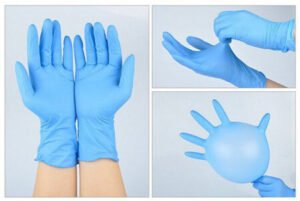What Type of Gloves Do They Use in Hospitals?
Table of Contents
- Overview of Hospital Gloves
- Main Types of Medical Gloves
- Key Selection Factors for Hospitals
- Manufacturing and Quality Standards
- Glove Usage by Hospital Department
- Cost and Budget Considerations
- Conclusion
Overview of Hospital Gloves
Medical gloves serve as a critical barrier between healthcare professionals and potential contaminants in hospital environments. These disposable protective devices are essential for preventing the transmission of infections, protecting both patients and medical staff during various procedures and examinations.
Hospitals typically use several different types of gloves depending on the specific application, risk level, and individual needs of healthcare workers. The choice of glove material can significantly impact safety, comfort, and overall effectiveness in medical settings.
Main Types of Medical Gloves
Nitrile Gloves
Nitrile gloves have become the preferred choice in most modern hospitals due to their excellent chemical resistance and latex-free composition. Made from synthetic rubber, these gloves provide superior protection against a wide range of chemicals and biological hazards while eliminating the risk of latex allergies.
The production of high-quality nitrile gloves requires advanced medical gloves machine technology that ensures consistent wall thickness and reliable barrier protection. These machines utilize precision dipping processes to create gloves that meet stringent medical standards.

Advantages of nitrile gloves:
- Excellent puncture and tear resistance
- Superior chemical resistance
- Latex-free formulation
- Good tactile sensitivity
- Available in various thicknesses
- Powder-free options available
Latex Gloves
Natural rubber latex gloves were historically the gold standard in medical settings due to their exceptional elasticity and comfort. However, their use has significantly decreased in many hospitals due to concerns about latex allergies among both healthcare workers and patients.
Despite allergy concerns, latex gloves are still used in certain specialized procedures where maximum dexterity and tactile sensitivity are crucial. Some surgical procedures still rely on latex gloves for their superior fit and feel.
Characteristics of latex gloves:
- Exceptional elasticity and stretch
- Superior tactile sensitivity
- Excellent barrier protection
- Biodegradable material
- Potential for allergic reactions
- Requires proper storage conditions

Vinyl Gloves
Vinyl gloves, manufactured from polyvinyl chloride (PVC), represent the most cost-effective option for hospitals. These gloves are suitable for low-risk procedures and routine patient care activities where extended chemical exposure is not expected.
While vinyl gloves offer basic protection, they have limitations in terms of durability and barrier protection compared to nitrile and latex alternatives. They are commonly used for food service, housekeeping, and basic patient care tasks.
Properties of vinyl gloves:
- Most economical option
- Latex-free composition
- Easy to put on and remove
- Limited chemical resistance
- Less durable than other options
- Suitable for short-term use
Specialty Medical Gloves
Hospitals also utilize specialized gloves for specific applications, including:
- Surgical gloves: Sterile, high-quality gloves for surgical procedures
- Chemotherapy gloves: Specialized protection against cytotoxic drugs
- Radiation protection gloves: Lead-lined gloves for radiology departments
- Extended wear gloves: Designed for longer procedures
Key Selection Factors for Hospitals
Protection Level Requirements
The level of protection required varies significantly across different hospital departments and procedures. High-risk areas such as operating rooms and infectious disease units require gloves with superior barrier properties, while routine patient care may utilize standard protection gloves.
Modern medical gloves machine technology enables manufacturers to produce gloves with varying protection levels, allowing hospitals to select appropriate products for specific applications. Quality control systems ensure consistent barrier protection across all manufactured gloves.
Protection considerations include:
- Barrier effectiveness against pathogens
- Chemical resistance requirements
- Puncture and tear resistance
- Duration of exposure
- Risk level of procedures
Comfort and Fit Considerations
Healthcare workers often wear gloves for extended periods, making comfort and proper fit essential factors in glove selection. Poorly fitting gloves can cause hand fatigue, reduce dexterity, and potentially compromise safety.
Hospitals typically stock multiple sizes and may offer gloves with different cuff lengths or textured surfaces to accommodate various preferences and requirements. The manufacturing process using advanced medical gloves machine systems allows for precise sizing and consistent quality.
Manufacturing and Quality Standards
Medical gloves used in hospitals must meet strict regulatory standards established by organizations such as the FDA, ASTM International, and European Norm (EN). These standards ensure that gloves provide adequate protection and meet safety requirements for medical use.
The manufacturing process involves sophisticated medical gloves machine equipment that maintains precise control over material composition, wall thickness, and overall quality. Automated testing systems check each batch for defects, ensuring consistent performance standards.
Key quality standards include:
- ASTM D6319 for nitrile examination gloves
- ASTM D3578 for latex examination gloves
- ASTM D5250 for vinyl examination gloves
- FDA 510(k) clearance for medical devices
- ISO 13485 quality management systems
Glove Usage by Hospital Department
Surgical Units
Operating rooms require the highest quality sterile gloves, typically made from latex or high-grade nitrile materials. These gloves must provide maximum dexterity and tactile sensitivity while maintaining sterile conditions throughout surgical procedures.
Surgical gloves often feature specialized packaging and sterilization processes to ensure they meet stringent sterility requirements. Double-gloving is common in high-risk surgical procedures.
Emergency Departments
Emergency departments typically use nitrile gloves due to their durability and chemical resistance. The fast-paced environment requires gloves that can withstand frequent changes and provide reliable protection against unknown contaminants.
Emergency departments often stock gloves in multiple sizes and may use powder-free options to reduce the risk of allergic reactions in both staff and patients.
General Patient Care
General patient care units often utilize a combination of nitrile and vinyl gloves, depending on the specific tasks being performed. Routine care activities may use vinyl gloves for cost-effectiveness, while procedures involving potential exposure to bodily fluids require nitrile gloves.
Cost and Budget Considerations
Hospital administrators must balance cost considerations with safety requirements when selecting medical gloves. While vinyl gloves are the most economical option, they may not provide adequate protection for all applications, potentially leading to higher costs due to increased risk of contamination or injury.
Nitrile gloves, while more expensive initially, often provide better value due to their durability, reduced allergy risk, and superior protection. Many hospitals find that investing in higher-quality gloves reduces overall costs by preventing complications and improving staff satisfaction.
Cost factors include:
- Initial purchase price per unit
- Usage rates and waste
- Storage and inventory costs
- Potential costs of allergic reactions
- Risk of contamination or injury
- Staff productivity and comfort
Conclusion
The selection of appropriate gloves is a critical decision for hospitals that impacts patient safety, staff protection, and overall infection control protocols. Nitrile gloves have emerged as the preferred choice for most hospital applications due to their excellent protection properties, latex-free composition, and overall reliability.
While latex gloves still have specialized applications in certain surgical procedures, the trend toward nitrile and other synthetic materials continues to grow. Vinyl gloves remain useful for low-risk applications where cost-effectiveness is a primary concern.
Hospitals must carefully evaluate their specific needs, considering factors such as procedure types, staff allergies, protection requirements, and budget constraints. By working with reputable suppliers and maintaining strict quality standards, healthcare facilities can ensure they have access to the protective equipment necessary to maintain the highest levels of patient care and staff safety.
The continued advancement in manufacturing technology and materials science promises even better glove options in the future, with improved comfort, protection, and environmental sustainability.
Read More: https://jubaomachine.com/new/
